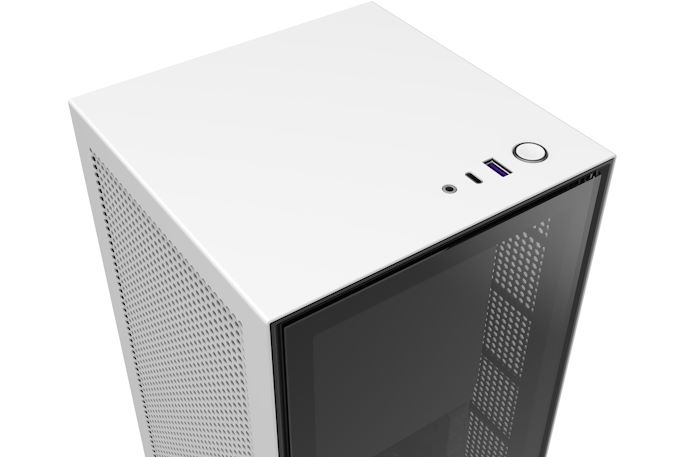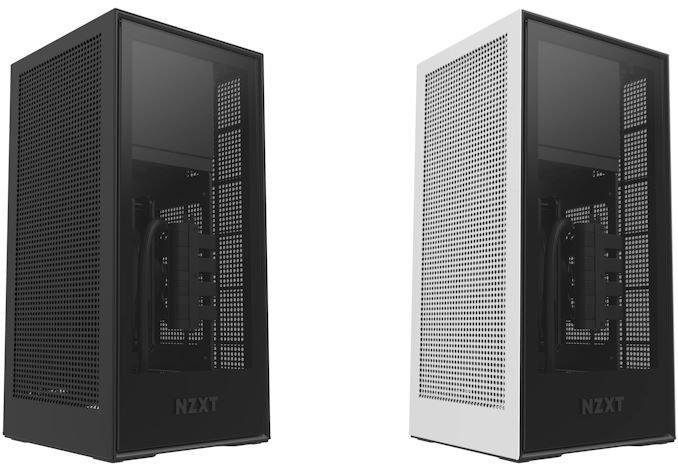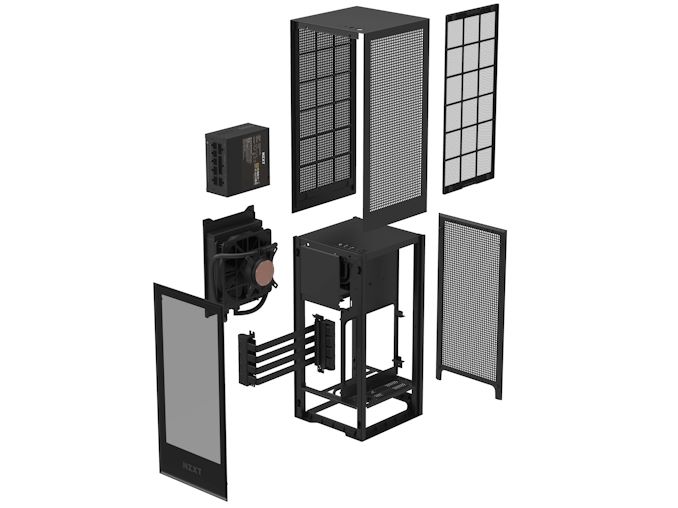NZXT Debuts H1 Mini-ITX Case for Big Gaming Rigs & NZXT BLD H1 Mini PC
by Anton Shilov on February 26, 2020 4:00 PM EST- Posted in
- Cases/Cooling/PSUs
- Mini ITX
- NZXT
- Cases

Small form-factor gaming PCs are on the rise these days, but because leading-edge components like CPUs and GPUs tend to produce a lot of heat and therefore require bulky cooling systems, it is not easy to build a truly compact PC with top-of-the-range components. Some makers of chassis attempt to design compact cases for gaming desktops, and this week NZXT introduced its Mini-ITX case for systems with leading-edge hardware. Alongside the Mini-ITX case, the company also unveiled its NZXT BLD H1 Mini PC that packs Intel’s Core i9-9900K and NVIDIA’s GeForce RTX 2070 Super.
The NZXT H1 Mini-ITX case is dual-chamber 13.6-liter vertical chassis made of stainless steel and tempered glass that can house a Mini-ITX motherboard, an up to 305-mm long 2.5-wide graphics card, and two 2.5-inch storage devices. The case measures 187 mm × 387.7 mm × 187.6 mm, which is a little bit larger than one comes to expect from a Mini-ITX chassis, but which is still considerably more compact than almost any Micro-ATX case. The chassis has air intakes on two sides out of four, to ensure proper cooling for the internal hardware.
NZXT’s H1 comes with a pre-installed 140-mm closed-loop CPU liquid cooling system, a PCIe 3.0 x16 riser card, filters on air intakes, and a 650 W SFX-L 80 Plus modular PSU. The upper panel has a USB Type-A and a USB Type-C connector as well as a 3.5-mm combo audio jack. As the case — set to be available in black or white — is stuffed by default with a PSU and a cooler, the product will retail for a higher $349 price.
In addition to the case itself, NZXT will offer its pre-built BLD H1 Mini PC that is based on Intel’s Core i9-9900K CPU as well as NVIDIA’s GeForce RTX 2070 Super Founder’s Edition graphics card. The system uses the ASUS ROG Strix Z390-I motherboard and is equipped with Team Group’s 16 GB of DDR4-3200 memory, and Intel’s 1 TB 660p SSD. The system costs $1,999.
Related Reading:
- NZXT Unveils Kraken X-3 and Kraken Z-3 Series Closed-Loop CPU Coolers
- NZXT Releases C-Series PSUs: 80Plus Gold and up to 850W, Built By Seasonic
- NZXT Refreshes H Series, New H510 Elite Chassis With RGB
- CES 2020: ASUS Unveils ROG Z11 Mini ITX Chassis For Gamers
- ASUS ROG Strix X570-I Gaming Mini-ITX Motherboard: Wi-Fi 6, Dual PCIe 4.0 M.2
- ZADAK Demonstrates MOAB: "World’s First Portable Water-Cooled PC"
Source: NZXT












32 Comments
View All Comments
J3EBS - Wednesday, February 26, 2020 - link
I'm esctatic to (finally) see a good, competitively priced and feature-rich sub-20L case from one of the major manufacturers. With the likes of the Ncase, Dan case, Louqe etc. always being so hard to find, the demand for this will be high and hopefully others follow suit.Alistair - Wednesday, February 26, 2020 - link
i personally dislike our obsession with litres, the most efficient dimensions for high volume in a smaller size is the cube, so when they make a weird long or tall case, they can claim it is small because it has a small volume, which seems silly personallyLian Li TU150's 312mm x 203mm x 375mm is just as small as this one's 187 mm × 387.7 mm × 187.6 mm in my opinion...
Alistair - Wednesday, February 26, 2020 - link
i guess i'm wondering, can the NZXT work well on it's side so that it is 387mm long instead of tall? anyone know?Valantar - Wednesday, February 26, 2020 - link
As long as you put the TG side down it should probably be okay. Anything else and you'll hurt the already high thermals.inighthawki - Wednesday, February 26, 2020 - link
If you dont want to restrict the airflow you can always lay it on it's front where the glass panel is. You may risk scratching it depending on what type of surface you put it on but it would be functionally just fine.Otherwise as long as you're willing that airflow may be worse I dont see any reason you cant place it in any orientation you'd want.
007ELmO - Wednesday, February 26, 2020 - link
I don't consider a case this tall to be tiny. Also, please put a handle on any and all mini itx cases.Valantar - Thursday, February 27, 2020 - link
It's tiny for a mainstream itx case. Sure, there are much, much smaller niche alternatives, but unlike those this will be easy to buy for pretty much everyone.Also, no. Not everyone wants a small case to lug it around. Handles can be useful, but saying all itx cases should have them is just silly. Besides, don't you want to put your case in a bag or something to protect it?
sharath.naik - Friday, February 28, 2020 - link
This case makes very little sense. The only reason for sandwich layout is for compactness, to get the volume of the case to below 10Liters(Dan a4 7L, Ghost s1 8L). You can have a traditional layout without a riser card at 12.6Litre like NCase m1. The traditional layout gives you all the cooling you need and all the flexibility and compatibility of components like Cooling/GPU/Storage. So why would anyone design a >13L case in the sandwich layout!!!.Right now the Choices for cases with full length GPUs as
1. Dan Case 7L Smallest possible/Lightest but with limited CPU air cooling choices.
2. Ghost s1 8L Beautiful/Sturdy/Expandable(tophats) just like Dan but heavier but provides extra headroom for CPU cooling and clean cable management and storage
Then for the standard layout, you have NCase m1.
Kangal - Thursday, February 27, 2020 - link
Alistair, you have NOT thought this through.The best shape is the one that maximises Surface Area. Why? Cooling Obviously!
Motherboards are square in shape, as is the PSU. The GPU are rectangle.
The best design, thermally, is to have it stand upwards like a building.
In terms of Heat Generation, the GPU comes first, then CPU, and a distant third is the PSU. So ideally you want the "hottest" towards the bottom, so that's the GPU taking one side by itself. And the other side should have the CPU on the bottom, and the PSU on the top, stacked together to make a rectangle. The GPU should be an "Axial" Design with Two Fans. And the fans should be "inverted" which is a very simple mod. This mod allows the Graphics Card "sucks" air from the top (where the ports are), and it "blows" it out from the side, making it more efficient to get rid of the hot air and as far away from the PC as possible. In a Standard Axial Design, the twin GPU fans "suck" air from the face-side, and exhaust it out the port-side, which is thermally good for a large ATX case with multiple cooling points, but is only "okay" in a mini tower we've described in its default orientation. Yes, even slightly better than the Blower-Style graphic cards.
And when maximising for space and thermals, you would use Air-Cooling. So basically, that's what mITX owners should strive for. Water cooling uses more space and doesn't perform as well. Not to mention downsides to cost, leakage worry, more moving parts, and higher power draw. The main benefit of Water Cooling is the acoustic improvement thanks to a large radiator, and larger slow moving fans. Also, if you are in a "hot room" with low ventilation, a Water Cooled solution can keep the temperatures more consistent for a longer time.
brontes - Friday, February 28, 2020 - link
> leakage worry, more moving parts, and higher power draw"Leaks" are solved with a one time check pressuring with air. They don't develop over time.
You have one moving part--the pump--which is usually a D5 which is an industrial part that uses water/self lubricating ceramic.
Power draw is pretty negligible. With your one moving part (pump) uses 24W max at full power but will usually run around 50%.
> doesn't perform as well
In small form factors this would be heavily dependant on the case design.
Yes it takes up more room so air may be more effective, yes it has a high initial outlay cost, yes it has a learning curve, yes it's $60 every socket change and $120 every gpu change. Yes it's a bitch getting everything set up in a small area initially.
Yes it'll be a hell of a lot quieter than your double axial blower, even with limited rad area and faster fans.
But it really depends on the case. It's hard to tell on this one what's possible even with all the extra pics on the product page.
But to the topic at hand, if you could have it lay down and radiator a single exposed side you'd be fine.